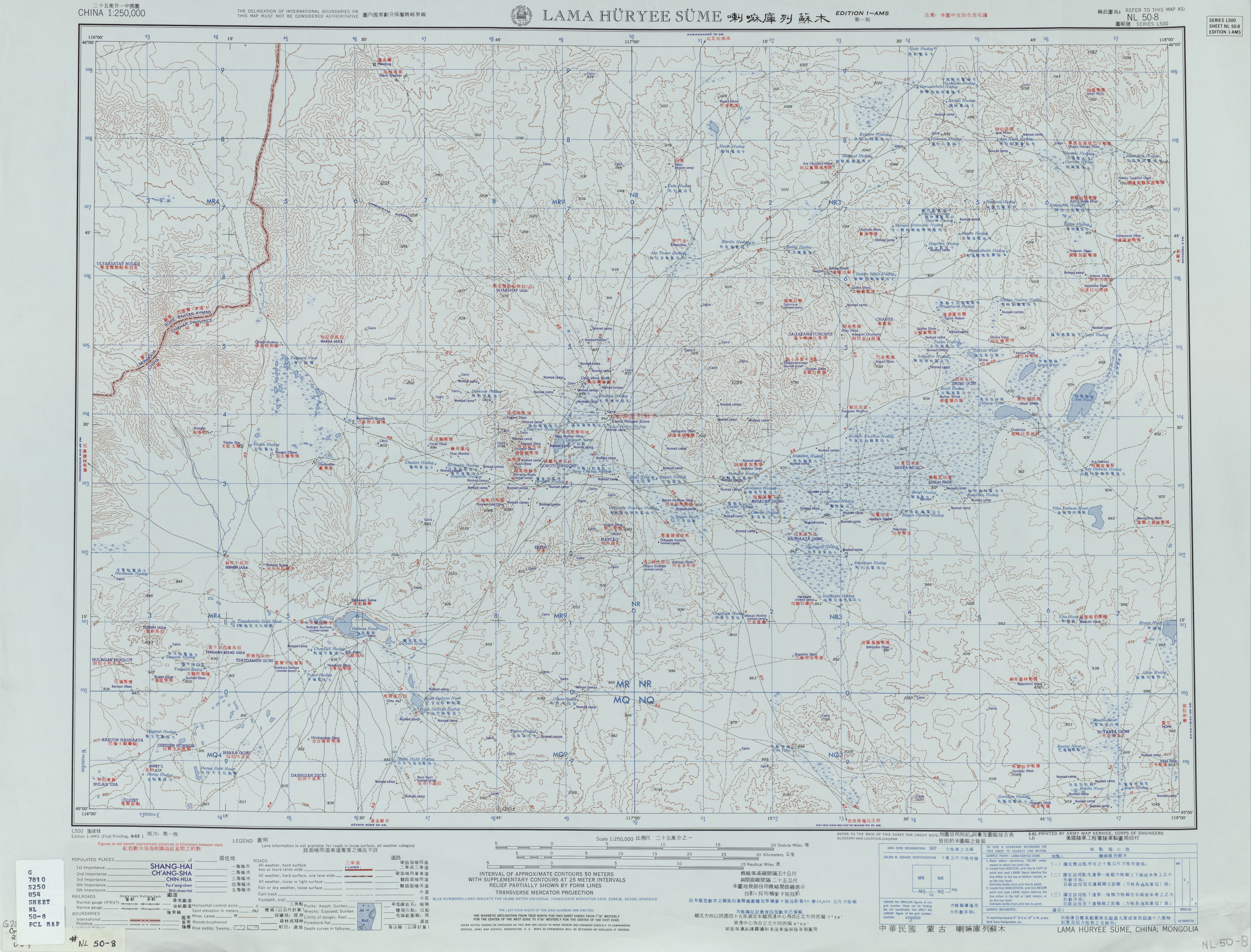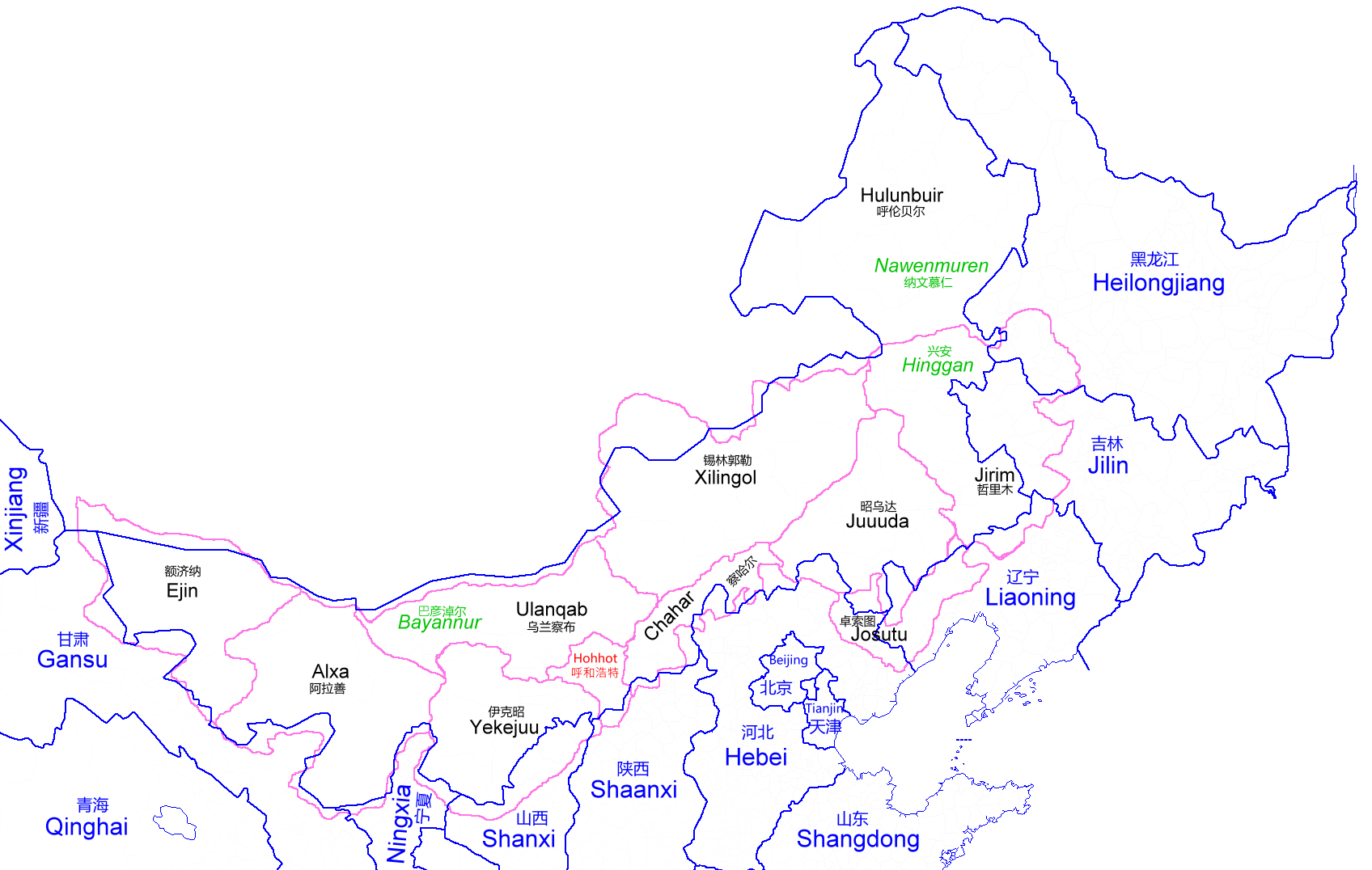|
East Ujimqin Banner
East Ujimqin Banner ( Mongolian: ''Jegün Ujumučin qosiɣu''; ) is a banner in the northeast of the Inner Mongolia Autonomous Region, People's Republic of China. It is under the administration of Xilin Gol League. Geography and climate East Ujimqin features a cold semi-arid climate A semi-arid climate, semi-desert climate, or steppe climate is a dry climate sub-type. It is located on regions that receive precipitation below potential evapotranspiration, but not as low as a desert climate. There are different kinds of semi-ar ... ( Köppen ''BSk''), marked by long, cold and very dry winters, hot, somewhat humid summers, and strong winds, especially in spring. The monthly daily mean temperature in January, the coldest month, is , and in July, the warmest month, , with the annual mean at . The annual precipitation is approximately , with more than half of it falling in July and August alone. Due to the aridity and elevation, diurnal temperature variation often exceeds in spr ... [...More Info...] [...Related Items...] OR: [Wikipedia] [Google] [Baidu] |
Banner (Inner Mongolia)
A banner (, as "khoshun" in Mongolian) is an administrative division of the Inner Mongolia Autonomous Region in China, equivalent to a county-level administrative division. Banners were first used during the Qing dynasty, which organized the Mongols into banners except those who belonged to the Eight Banners. Each banner had sums as nominal subdivisions. In Inner Mongolia, several banners made up a league. In the rest, including Outer Mongolia, northern Xinjiang and Qinghai, Aimag (Аймаг) was the largest administrative division. While it restricted the Mongols from crossing banner borders, the dynasty protected Mongolia from population pressure from China proper. After the Mongolian People's Revolution, the banners of Outer Mongolia were abolished in 1923. There were 49 banners and 24 tribes in Inner Mongolia during the Republic of China. Today, banners are a county-level division in the Chinese administrative hierarchy. There are 52 banners in total, include 3 a ... [...More Info...] [...Related Items...] OR: [Wikipedia] [Google] [Baidu] |
People's Republic Of China
China, officially the People's Republic of China (PRC), is a country in East Asia. It is the world's most populous country, with a population exceeding 1.4 billion, slightly ahead of India. China spans the equivalent of five time zones and borders fourteen countries by land, the most of any country in the world, tied with Russia. Covering an area of approximately , it is the world's third largest country by total land area. The country consists of 22 provinces, five autonomous regions, four municipalities, and two Special Administrative Regions (Hong Kong and Macau). The national capital is Beijing, and the most populous city and financial center is Shanghai. Modern Chinese trace their origins to a cradle of civilization in the fertile basin of the Yellow River in the North China Plain. The semi-legendary Xia dynasty in the 21st century BCE and the well-attested Shang and Zhou dynasties developed a bureaucratic political system to serve hereditary monarchies, or dyna ... [...More Info...] [...Related Items...] OR: [Wikipedia] [Google] [Baidu] |
Autonomous Regions Of The People's Republic Of China
The autonomous regions () are the highest-level administrative divisions of China. Like Chinese provinces, an autonomous region has its own local government, but under Chinese law, an autonomous region has more legislative rights, such as the right to "formulate self-government regulations and other separate regulations." An autonomous region is the highest level of minority autonomous entity in China, which has a comparably higher population of a particular minority ethnic group. The autonomous regions are the creations of the People's Republic of China (PRC), as they are not recognized by the Republic of China (ROC) based in Taiwan, which previously ruled Mainland China before the PRC's establishment in 1949. History Established in 1947, the Inner Mongolia Autonomous Region became the first autonomous region in the Chinese liberated zone. Xinjiang was made autonomous in 1955 after the PRC's founding, and Guangxi and Ningxia were made autonomous in 1958. Tibet was placed u ... [...More Info...] [...Related Items...] OR: [Wikipedia] [Google] [Baidu] |
Inner Mongolia
Inner Mongolia, officially the Inner Mongolia Autonomous Region, is an autonomous region of the People's Republic of China. Its border includes most of the length of China's border with the country of Mongolia. Inner Mongolia also accounts for a small section of China's border with Russia (Zabaykalsky Krai). Its capital is Hohhot; other major cities include Baotou, Chifeng, Tongliao, and Ordos. The autonomous region was established in 1947, incorporating the areas of the former Republic of China provinces of Suiyuan, Chahar, Rehe, Liaobei, and Xing'an, along with the northern parts of Gansu and Ningxia. Its area makes it the third largest Chinese administrative subdivision, constituting approximately and 12% of China's total land area. Due to its long span from east to west, Inner Mongolia is geographically divided into eastern and western divisions. The eastern division is often included in Northeastern China (Dongbei) with major cities including Tongliao, Chifeng, Hai ... [...More Info...] [...Related Items...] OR: [Wikipedia] [Google] [Baidu] |
Leagues Of China
A league ( ''ayimaγ'' ''Aimag''; historically, ''čiγulγan'' ''Qûûlgan''; ) is an administrative unit of the autonomous region of Inner Mongolia in the People's Republic of China. Leagues are the prefectures of Inner Mongolia. The name comes from a Mongolian administrative unit used during the Qing dynasty in Mongolia. Mongolian Banners (county level regions) were organized into conventional assemblies at the league level. During the ROC era, the leagues had a status equivalent to provinces. Leagues contain banners, equivalent to counties. After the establishment of the provincial level Inner Mongolia Autonomous Region in 1947, leagues of Inner Mongolia became equal to prefectures in other provinces and autonomous regions. The administrative commission () of the league is the administrative branch office dispatched by the People's Government of Inner Mongolia Autonomous Region. The leader of the league's government, titled as league leader (), is appointed by People' ... [...More Info...] [...Related Items...] OR: [Wikipedia] [Google] [Baidu] |
Xilin Gol
Xilingol, Xilin Gol, Shiliin Gol or Xilinguole Aimag/League (; mn, , , , ) is one of 3 leagues of Inner Mongolia. The seat is Xilinhot, and the area is . The league's economy is based on mining and agriculture. Xilingol borders Mongolia to the north, Chifeng, Tongliao and Hinggan League to the east, Ulanqab to the west and Hebei to the south. This is the only prefecture-level division of Inner Mongolia in whose southern border nomadic culture is still vivid. Some divisions, such as Tongliao, have a much higher percentage of Mongolian population, but agriculture is extensive among Khorchin Mongols there. Xilingol League is also the closest Inner Mongolian prefecture-level division to Beijing; although, among those Inner Mongolian prefecture-level divisions bordering Hebei, the province surrounding Beijing, Xilin Gol is also the most unapproachable one. With a significant population of Chakhar Mongols, who speak a Mongolian dialect closely related to the standard dialect of Mong ... [...More Info...] [...Related Items...] OR: [Wikipedia] [Google] [Baidu] |
China Standard Time
The time in China follows a single standard time offset of UTC+08:00 (eight hours ahead of Coordinated Universal Time), even though the country spans almost five geographical time zones. The official national standard time is called ''Beijing Time'' (BJT, ) domestically and ''China Standard Time'' (CST) internationally. Daylight saving time has not been observed since 1991. China Standard Time (UTC+8) is consistent across Mainland China, Hong Kong, Macau, Taiwan, Philippines, Singapore, Brunei, Mongolia, etc. History In the 1870s, the Shanghai Xujiahui Observatory was constructed by a French Catholic missionary. In 1880s officials in Shanghai French Concession started to provide a time announcement service using the Shanghai Mean Solar Time provided by the aforementioned observatory for ships into and out of Shanghai. By the end of 19th century, the time standard provided by the observatory had been switched to GMT+08:00. The practice has spread to other coastal ports, and in ... [...More Info...] [...Related Items...] OR: [Wikipedia] [Google] [Baidu] |
Postal Code Of China
Postal codes in the People's Republic of China () are postal codes used by China Post for the delivery of letters and goods within mainland China. China Post uses a six-digit all-numerical system with four tiers: the first tier, composed of the first two digits, show the province, province-equivalent municipality, or autonomous region; the second tier, composed of the third digit, shows the postal zone within the province, municipality or autonomous region; the fourth digit serves as the third tier, which shows the postal office within prefectures or prefecture-level cities; the last two digits are the fourth tier, which indicates the specific mailing area for delivery. The range 000000–009999 was originally marked for Taiwan (The Republic of China) but is not used because it not under the control of the People's Republic of China. Mail to ROC is treated as international mail, and uses postal codes set forth by Chunghwa Post. Codes starting from 999 are the internal codes use ... [...More Info...] [...Related Items...] OR: [Wikipedia] [Google] [Baidu] |
Mongolian Language
Mongolian is the official language of Mongolia and both the most widely spoken and best-known member of the Mongolic language family. The number of speakers across all its dialects may be 5.2 million, including the vast majority of the residents of Mongolia and many of the ethnic Mongol residents of the Inner Mongolia Autonomous Region of the People's Republic of China.Estimate from Svantesson ''et al.'' (2005): 141. In Mongolia, Khalkha Mongolian is predominant, and is currently written in both Cyrillic and traditional Mongolian script. In Inner Mongolia, the language is dialectally more diverse and is written in the traditional Mongolian script. However, Mongols in both countries often use the Latin script for convenience on the Internet. In the discussion of grammar to follow, the variety of Mongolian treated is the standard written Khalkha formalized in the writing conventions and in grammar as taught in schools, but much of what is to be said is also valid for vernacular ... [...More Info...] [...Related Items...] OR: [Wikipedia] [Google] [Baidu] |
Xilin Gol League
Xilingol, Xilin Gol, Shiliin Gol or Xilinguole Aimag/League (; mn, , , , ) is one of 3 leagues of Inner Mongolia. The seat is Xilinhot, and the area is . The league's economy is based on mining and agriculture. Xilingol borders Mongolia to the north, Chifeng, Tongliao and Hinggan League to the east, Ulanqab to the west and Hebei to the south. This is the only prefecture-level division of Inner Mongolia in whose southern border nomadic culture is still vivid. Some divisions, such as Tongliao, have a much higher percentage of Mongolian population, but agriculture is extensive among Khorchin Mongols there. Xilingol League is also the closest Inner Mongolian prefecture-level division to Beijing; although, among those Inner Mongolian prefecture-level divisions bordering Hebei, the province surrounding Beijing, Xilin Gol is also the most unapproachable one. With a significant population of Chakhar Mongols, who speak a Mongolian dialect closely related to the standard dialect of Mong ... [...More Info...] [...Related Items...] OR: [Wikipedia] [Google] [Baidu] |


.jpeg/1200px-Siège_de_Beijing_(1213-1214).jpeg)


